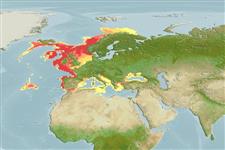Ophiuroidea |
Amphilepidida |
Ophiotrichidae
Environment: milieu / climate zone / depth range / distribution range
Ecology
Benthic; brackish; depth range 0 - 1244 m (Ref. 85345). Subtropical
Northeast Atlantic and the Mediterranean: Europe. Temperate and subtropical.
Length at first maturity / Size / Weight / Age
Maturity: Lm ? range ? - ? cm
Found in muddy bottoms in the sub-littoral to bathyal zones (Ref. 96352). A passive suspension feeder (Ref. 96376). A microvore-carnivore-scavenger that feeds on organic detritus and animal matter (Ref. 96352).
Life cycle and mating behavior
Maturity | Reproduction | Spawning | Eggs | Fecundity | Larvae
Members of the class Ophiuroidea are mostly gonochoric, others are protandric. Fertilization is external. Brooding is common, bursae is used as brood chambers where the embryos develop into juveniles and later crawl out from the bursal slits. Life cycle: Embryos hatch into free-swimming planktotrophic larvae and later metamorphose into tiny brittle stars which sink down the bottom where they grow into adult form.
Harms, J. 1993 Check list of species (algae, invertebrates and vertebrates) found in the vicinity of the island of Helgoland (North Sea, German Bight) - a review of recent records. Helgoländer Meeresunters 47:1-34. (Ref. 2711)
IUCN Red List Status
(Ref. 130435: Version 2025-1)
CITES status (Ref. 108899)
Not Evaluated
Not Evaluated
Threat to humans
Human uses
| FishSource |
Tools
More information
Population dynamicsGrowthMax. ages / sizesLength-weight rel.Length-length rel.Length-frequenciesMass conversionAbundance Life cycleReproductionMaturityFecunditySpawningEggsEgg developmentLarvae PhysiologyOxygen consumption
Human RelatedStamps, coins, misc.
Internet sources
Estimates based on models
Preferred temperature
(Ref.
115969): 5.1 - 11.3, mean 7.9 (based on 220 cells).
Price category
Unknown.
